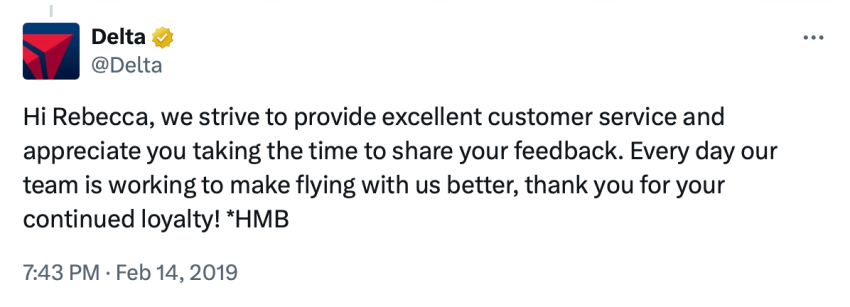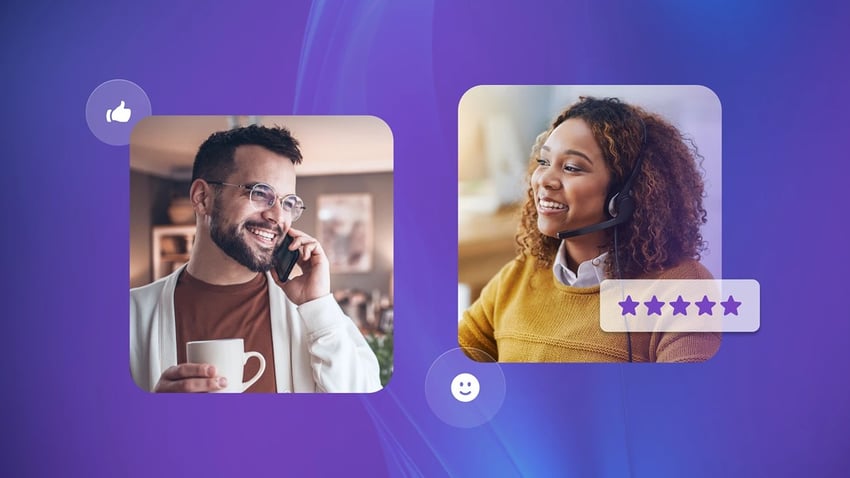The quality of your customer service can make or break your business. According to American Express, one-third of Americans would consider switching providers after just one bad customer service experience.
That’s right. One bad customer service conversation can be fatal to your business.
It shouldn’t be a surprise. Chances are, you’ve been on the receiving end of difficult customer at least once in your life. Traumatic experience, right?
Skip right to the 9 worst phrases >>>
The opposite of poor customer experience is customer success. Sixteen Ventures CEO and customer service expert Lincoln Murphy define customer service as “the moment when your customer achieves their Desired Outcome through their interactions with your company.”
Skip to the 12 phrases you MUST use >>>
Murphy emphasizes “interactions with your company” to raise a critical point. Your customer experience is not just the use of your product or service. It’s every engagement they have with your company, product, and employees included, where customer service plays a key role.

What dictates customer experience? Your employees.
As CX Journey CEO Annette Franz points out, “the employee experience drives the customer experience. It’s called the spillover effect, or ‘the tendency of one person’s emotions to affect how other people around him feel.’”
Pro Tip: We recently published 100+ stats on customer service you definitely need to check out after reading this article.
9 Customer Service Phrases You Should Never Say
- “I’m not sure.”
- “Let me check.”
- “I can’t help you.”
- “Visit our Help Center instead.”
- “Calm down.”
- “You’re mistaken.”
- “I’m having a bad day.”
- “We’ve never had this issue before.”
- “Let me call you back.”
The quality of your customer service depends on your customer service team having great communication with your client base.
A lot of lip service gets paid to teaching reps what to say on a customer service call. But it’s equally important to know what not to say.

Exceptional Service, Exceptional Profit author Michael Solomon calls out an excellent customer service practice in his book.
“Great companies develop a set of key phrases to use — and not use — in talking to customers,” says Entrepreneur writer Carol Tice. “Solomon reports that Ritz-Carlton hotel employees carry pocket-sized cards with reminders of recommended and discouraged phrases to use in common scenarios.”
This is where this article comes in – submitted below are 9 awful phrases you should NEVER say on a customer service call under any circumstances and 12 excellent customer service phrases that you should use frequently.
1. “I’m not sure.”
There are a million better ways to respond to a customer question you’re uncertain of than the outright omission, “I’m not sure.”
This phrase is often used when a customer service representative does not have immediate knowledge of or a solution to a customer’s issue. It’s the verbal equivalent of throwing your hands in the air – it signifies helplessness and lack of competence.
While it’s intended to be an honest admission of uncertainty, it can inadvertently convey unprofessionalism or a lack of commitment to resolving the customer’s problems. Customers may feel frustrated or lose confidence in the service provider, believing that their concerns are not being taken seriously.
You’re better off pushing for more information to get a better idea of what they are saying.
2. “Let me check.”
“Let me check” is a vague phrase that leaves your customer in limbo. It might leave customers wondering about what’s happening behind the scenes, potentially causing anxiety or impatience if they feel left out of the loop.
Rather, be more specific.
For instance, saying, “I am going to verify this detail with our technical team to ensure we resolve your issue accurately,” helps set clear expectations and gives the customer insight into the process.
Don’t use “let me check” in isolation unless you want to raise your customer’s blood pressure unnecessarily.
3. “I can’t help you.”
This should be a no-brainer, but we’ve all been on the receiving end of this phrase with a customer service rep at one time or another.
ChurnZero Director of Marketing Cori Pearce cites “declining help with no context” as an easy-to-miss customer service blunder you should avoid at all costs.
The standalone phrase “I can’t help you” does not belong in the customer service lexicon. While it may be a straightforward acknowledgment of limitations, it can be very disheartening for the customer to hear. This expression can quickly diminish the customer’s trust and confidence in the service provider, making them feel abandoned in their time of need.
A better way to express this is to use phrases like, “Let me connect you with someone who specializes in this area,” or “I will escalate this issue to our senior team to ensure you get the necessary support.” This type of response shows the customer that efforts are being made to resolve their issue, even if the initial contact cannot directly solve the problem.
Also: Per Dimensional Research, 72 percent of consumers see having to explain their problem to multiple people as poor customer service. Therefore – it’s best to set up your customer service CRM process to keep the conversation with one rep as often as possible.
4. “Visit our Help Center instead.”
It’s okay to advise customers to visit your Help Center after completing their customer service request (i.e. in cases where the Help Center has the information they need).
It’s not okay to use the Help Center as a way to get the customer off the call. Telling a customer to reference the Help Center while you’re on the phone with them is like someone you ask for directions handing you a map and saying, “figure it out.” Rude, unprofessional, and a huge turnoff to all.
It can even sometimes come across as dismissive or as shirking responsibility, especially if the customer has already attempted to solve the issue themselves or prefers a more personal interaction.
A better approach is saying, “Our Help Center has a detailed guide on this topic which might be very useful immediately. Would you like me to assist you in finding the right information there?” This approach not only guides them to the help they need but also keeps the interaction supportive and engaged.
Additionally, offering to follow up after customers visit the Help Center can enhance their experience and show a commitment to ensuring their issue is resolved.
Alternatively, opting for a friendly chatbot could save the day when your team is bogged down with calls. Reps wouldn’t be compelled to redirect customers to a help center instead.

5. “Calm down.”
Would you wave a red flag in front of a charging bull? Telling a customer to “Calm down” might as well be the same thing.
If a customer is angry or upset, it is your job as the customer service rep to calm them down by solving their issue, not by telling them how they should be feeling.
To be fair, this is often much easier said than done and can require a great deal of self-control on the part of the customer service agent. People get irrationally upset, jump to negative conclusions, displace their anger or frustration with something else towards you, et cetera.
But it’s pivotal to maintain control even when your customer is a raging torrent of hate and anguish. Just don’t tell them to calm down.
6. “You’re mistaken.”
Any variation of “You’re mistaken” is disastrous. “You’re wrong.” “That’s wrong.” “Incorrect.” All off limits. This kind of direct contradiction can put the customer on the defensive, potentially leading to an argumentative or negative interaction.
Let’s double-check the first rule of business. Yep. It’s still “The customer is always right.”
Telling a customer that he or she is wrong is committing a cardinal sin. You’re breaking the first commandment of good business.
According to CX czar Blake Morgan, starting in the 1900s, “retailers knew the power of customers. They believed it’s better to trust customers and risk getting taken advantage of occasionally than to get a reputation of being mean or disrespectful.”
The customer can be as wrong as the day is long. The phrase, “You’re mistaken” should never be uttered from your mouth. Shy away from any language that smacks of correction or direct contradiction to what the customer is saying.
A more constructive response would be, “Let’s review the details together to ensure we’re on the same page,” or “I can see how this information might seem confusing. Let me clarify that for you.”
7. “I’m having a bad day.”
We all have bad days. Negative external forces and events are a reality of life, and it’s up to each and every customer service professional to make sure their customers never hear about them or how they are affecting us.
- Your coworkers? Yes.
- Your friends and family? Absolutely.
- Your customers? Never.
In a customer service context, this kind of personal disclosure can seem unprofessional. It shifts the focus from the customer’s needs to the representative’s personal issues, potentially making the customer feel that their concerns are secondary.
Important tip for customer service managers – if you have a rep who is going through a difficult time and is clearly emotional and struggling to maintain composure on the floor, it’s okay to give that person a quick break to regain his or her composure before interfacing with customers.
As CX expert Colin Shaw astutely asserts on his blog, “Employees are just like Customers in that they are at their best at work when they are Happy and Pleased.”
The bottom line: your employees are a reflection of your business. If they are clearly struggling on the phone with clients, in the mind of the customer, so is your business.
8. “We’ve never had this issue before.”
This futile attempt at reassurance makes no difference in the mind of the customer, who is currently experiencing the issue and now feels more alarmed upon hearing that it’s a new problem your company has never had to solve before.
There are other ways to reassure customers that an issue they may be experiencing is rare and almost certain never to happen again. Whatever you do, do not use the “We’ve never had this issue before” approach.
9. “Let me call you back.”
Our 9th and final awful phrase should be another no-brainer. Yet, many companies fail to realize that no customer is willing to hang up mid-call and wait for you to call them back to finish resolving their issue.
If you need to do some serious research or consulting with your team prior to resolving their issue, let the customer know. Under no circumstances should you blindside a customer with a request to call them back.
12 Excellent Customer Service Phrases You Should Say
- “Thank you.”
- “I can absolutely help you with that.”
- Great question.”
- “I understand.”
- “What else can I help you with?”
- “How is your day going?”
- “I appreciate you bringing this to our attention.”
- “We appreciate your feedback.”
- “I can do that for you.”
- “Your business means a lot to us.”
- “I’m sending an update/confirmation.”
- “Did you know about our additional service?”
Looking to get ahead of the curve?

Use these 12 excellent customer service phrases to delight and excite your customers while they are on the phone with you.
1. “Thank you.”
Customers love to feel valued. Thanking them throughout the call – from its initial opening to the final sign-off, will dramatically increase the feelings of goodwill from the interaction.
Telling a customer “thank you” can occur at a variety of points throughout the conversation. Thank them for calling in, for being a customer, for raising an issue, for going through a troubleshooting scenario, and for their ongoing business.
Here’s a quick example: Say after resolving a customer’s issue, a representative might say, “Thank you for your patience while we resolved this matter,” or “Thank you for bringing this to our attention.” These phrases acknowledge the customer’s contribution to the interaction, whether it be their patience or their helpfulness in improving the service.
2. “I can absolutely help you with that.”
CX expert Ian Golding defines customer service as, “the assistance and advice provided by a company to those people who buy or use its products or services.”
The customer service phrase, “I can absolutely help you with that,” signals your willingness and ability to help the customer address whatever issue they’re facing. It conveys a strong commitment to the customer, instantly building trust and setting a positive tone for the interaction.
However, using this phrase effectively involves more than just making a promise; it requires follow-through. For example, after stating, “I can absolutely help you with that,” the representative might continue with, “Let me start by verifying your account details,” or “I will need to check the system and update you on the next steps.” This shows the customer a clear path forward and keeps them informed about the process.
Remember – customers are often calling you in a state of anxiety. This customer service phrase immediately dials that down.
3. “Great question.”
You have heard the phrase: “There’s no such thing as a dumb question.”
Guess what? That’s doubly true in customer service.
When a customer hits you with a reasonable query, this phrase affirms the validity of their call and signals that the conversation is heading down a good path. It also sets the stage for a meaningful exchange of information which should be followed by a comprehensive and thoughtful answer that addresses the customer’s inquiry fully.
An example of a follow-up to that can be “Here’s how that works…” or “To answer that, let’s consider…”
Customer Experience consultant and expert Jeannie Bliss captures the integral importance of communication to the customer experience on her blog. “Two-way trust, open and honest communication and fearless sharing are cornerstones of the relationships that come to mean the most to us.”
4. “I understand.”
Another response that alleviates customer anxiety and signals your own competency and ability to help. “I understand” is a great customer service phrase that reassures your customers that they’re on track to solving their problems.
To maximize the impact of “I understand,” follow up with a specific acknowledgment of the customer’s issue or sentiment and then an actionable step or solution.
For example, a representative might say, “I understand how frustrating it must be to experience this delay. Let me check what is causing the hold-up and how we can expedite your request.” This shows empathy and a proactive stance towards resolving the issue.
5. “What else can I help you with?”
The best customer service experience knocks out all customer concerns and issues in one fell swoop.
It demonstrates thoroughness and a genuine interest in the customer’s satisfaction, rather than just resolving a single issue or rushing through the service process. This question invites the customer to voice any other issues or questions they might have, potentially preventing future problems and enhancing their overall experience.
When used effectively, “What else can I help you with?” can make the customer feel valued and cared for, reinforcing a positive perception of the company. It should be delivered with a genuine openness to continue assisting, rather than as a mere formality.
6. “How is your day going?”
This question is a friendly and personable way to start a customer interaction. It helps establish a warm and approachable atmosphere, signaling to the customer that the service provider sees them as a person, not just another ticket number. This can be particularly effective in diffusing tension if the customer is calling with a complaint or problem, as it momentarily shifts the focus from the issue to the human connection.
This approach builds rapport and provides valuable context about the customer’s current state of mind and potentially their patience levels. Understanding this can help the representative tailor their approach to meet the customer’s emotional and service needs more effectively during the interaction.
As further proof, customer success influencer and Forbes Coaches Council author Jeannie Walters lists empathetic and engaging behavior as a trait of customer service superstars.
7. “I appreciate you bringing this to our attention.”
Using “I appreciate you bringing this to our attention” effectively transforms a potentially negative situation into a collaborative effort for improvement. It should be followed by an assurance that the issue will be addressed or an inquiry into further details to deepen understanding.
For example, a representative might say, “I appreciate you bringing this to our attention. Could you tell me more about what happened so we can make sure it doesn’t occur again?” This not only shows readiness to act on the feedback but also engages the customer in the problem-solving process.
8. “We appreciate your feedback.”
Similar to the previous customer service phrase, thanking a customer for feedback is a basic move you can execute that signals to your customer that your company is genuinely committed to problem-solving and improving the overall customer experience.

Using the inclusive “we” instead of “I” signals to your customer that you are speaking on behalf of the entire company when you thank them for their feedback. This also allows you to ask for a product or service review!
Pro Tip: Customer Service consultant and author Shep Hyken recommends using a single-question survey to determine the quality of a customer’s interaction with your business.“The next time you call us, would you want the same person to take care of you? Push 1 for yes and 2 for no.”
9. “I can do that for you.”
When a customer requests something that is within your scope of execution, let him or her know. Again, this customer service phrase quickly signals that the conversation is heading towards a positive resolution of the customer’s problems.
The goal is to mitigate customer anxiety as fast as possible. Use this phrase to get customers to let their guards down.
Additionally, when saying “I can do that for you,” combine this assurance with specifics about how the representative plans to resolve the issue or fulfill the request. For example, a representative might say, “I can do that for you right now. I just need a few details to proceed,” or “I can help you with that. Let’s get started by updating your information.”
10. “Your business means a lot to us.”
Every customer is important, regardless of how much they are paying your business. Treat them as such.
Never miss an opportunity to show gratitude to a customer. Use this customer service phrase early and often in customer conversations.

11. “I’m sending an update/confirmation.”
Making changes to a customer account? Rebooting his or her service? If your company sends a standard confirmation alert upon doing so, let the customer know you’ll be doing so while they are on the call.
Customers always appreciate written verification of issue resolution or account updates. Confirm they will receive one and push the conversation in the right direction.
12. “Did you know about our additional service?”
When the right opportunity to upsell or cross-sell presents itself, use it. If a call has gone well, you can always reference additional products or services that your customer may need but is not aware you provide. Used in the right situations, this phrase can generate more revenue and surprise and delight your customers.
What Are the Most Memorable Customer Service Phrases You’ve Heard?
The right or wrong customer service phrase can steer the entire direction of your call.
If there are two takeaways from this article, they are:
- Choose your words carefully with customers.
- Use a script if need be.
Remember: The Golden Rule, Karma, and the Law of Nature apply in business just as much as they do in life:
- You should treat your clients the way you would want to be treated.
- What goes around comes around.
- The arc of the moral universe is long, but it bends toward justice.
As the folks who put on Fyre Festival are finding out the hard way, these laws are very real. And they hold major implications for your business based on the customer experience you provide.

If you’re looking for a surefire way to improve the customer service experience in your business, check out Nextiva’s award-winning cloud communications platform for customer service teams.
Top AI-Powered Contact Center Solution
All conversations in one platform. Empowering agents. Satisfying customers.

















 Customer Experience
Customer Experience 











